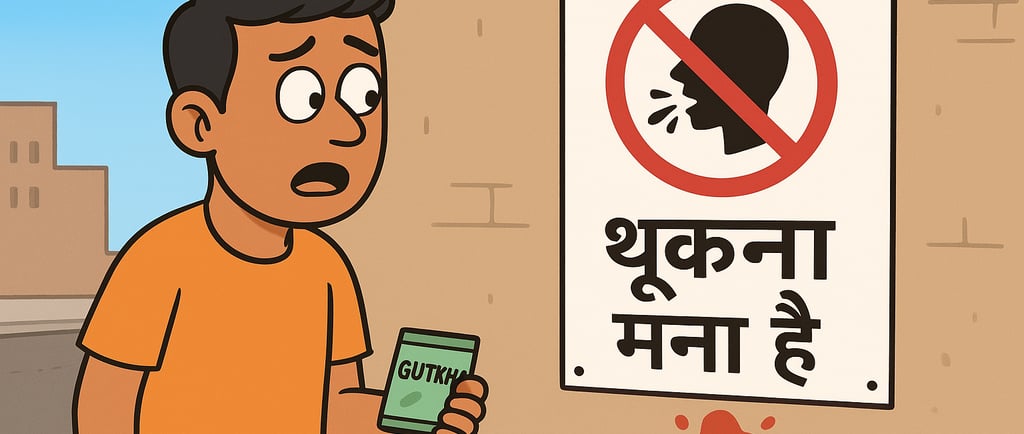Welcome
How Tobacco and Gutkha Are Destroying India from Within
10/30/20253 min read


In India, the consumption of gutkha, tobacco, and cigarettes has become a deep social and psychological problem. It is not just an addiction, but a habit that has hollowed out generations from within. From the first dose in the morning to the last puff at night, people are unknowingly fighting a battle against their own bodies. Today, the tobacco market in India is worth billions of dollars. The smokeless tobacco industry gutkha and khaini alone accounts for around 1.5 billion dollars, while the entire tobacco industry, including cigarettes and bidis, is several times larger. This “business of poison” has now become a part of the national economy, employing millions of people while costing millions their health.
India has one of the highest rates of tobacco consumption in the world. According to the Global Adult Tobacco Survey (GATS-2), about 267 million Indians use tobacco. Out of these, nearly 200 million consume smokeless forms like gutkha, khaini, zarda, or paan masala. These figures show that tobacco is no longer limited to a particular class or community. From small villages to big cities, every street corner and shop reflects its presence. It is an addiction that has deeply woven itself into the fabric of society and the most frightening part is that many now see it as “normal.”
The government earns a massive amount of revenue from the tobacco industry every year. Taxes, excise duties, and GST on cigarettes, bidis, and gutkha bring in billions of rupees annually. According to 2023–24 data, about 2% of India’s total tax revenue comes from tobacco products. But this “income” isn’t as sweet as it looks. The money earned through taxes is far outweighed by the expenses on healthcare, cancer treatment, and public sanitation. It’s a situation where revenue grows on one side, but the health system and environment pay the heavy price.
Every year, over 100 billion cigarettes are smoked in India, and their discarded filters and butts end up on roads, drains, and rivers. These contribute to more than 22,000 tons of waste, which eventually turns into microplastic in soil and water. Similarly, millions of gutkha pouches litter walls, pavements, and streets every day. This filth is not only unpleasant to look at but also burdens the public cleaning system with billions of rupees in extra costs. In developed nations like the UK and the USA, governments spend hundreds of millions annually just on cleaning tobacco waste. Although India doesn’t have official data, the sheer scale of visible waste tells its own story.
People who consume gutkha daily fail to realize that they are not only destroying their health but also draining their wallets. If a person chews an average of three pouches a day at ₹10 each, they spend about ₹11,000 a year on gutkha alone. Many consume even more, spending up to ₹30,000 annually money that could have gone toward savings or children’s education. This addiction silently weakens families financially.
On the health front, the impact is even more terrifying. Both gutkha and cigarettes are leading causes of several cancers oral cancer, throat cancer, lung cancer, gum infections, and tooth loss are all consequences of tobacco use. Every year, millions of Indians die from tobacco-related diseases. Most patients admitted to cancer wards in Indian hospitals are victims of gutkha or tobacco consumption. They not only lose their lives but also leave their families trapped in debt and despair.
Beyond health, there’s the issue of public cleanliness and image. India’s walls are stained red with spit, bus stops and railway stations are littered with cigarette butts these sights create a negative impression in the minds of foreign visitors. When tourists or investors see this, they feel that we do not care about our country or environment. This affects our tourism, business, and even national reputation.
The trade of gutkha and cigarettes harms not only our bodies but also the nation’s image, economy, and culture. It deepens poverty, destroys youth potential, and spreads filth across society. If India truly wants to become a healthy, clean, and aware nation, breaking free from this addiction is essential. This change requires not just laws but a transformation in mindset. Every individual must realize that tobacco is not “cool” it is a “killer.” Only when we take a personal pledge to neither consume tobacco nor let others do so, will true change begin.
1. Global Adult Tobacco Survey (GATS‑2) India Fact Sheet 2016-17 PDF: https://www.mohfw.gov.in/sites/default/files/GATS-2%20FactSheet.pdf
2. India Smokeless Tobacco Market Report - TechSci Research: https://www.techsciresearch.com/news/23497-india-smokeless-tobacco-market.html
3. “Why India must act on cigarette butts and sachets” - The New Indian Express article: https://www.newindianexpress.com/xplore/2025/Sep/19/why-india-must-act-on-cigarette-butts-and-sachets
4. “Cigarette butts are the most littered form of plastic in India” https://www.allindiansmatter.in/cigarette-butts-are-the-most-littered-form-of-plastic-in-india/
5. India Tobacco Country Profile TobaccoTactics: -https://www.tobaccotactics.org/article/india-country-profile/